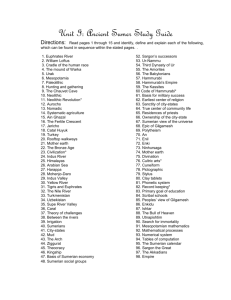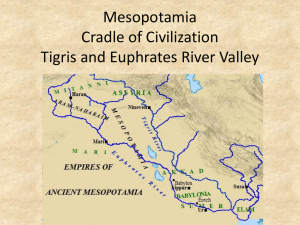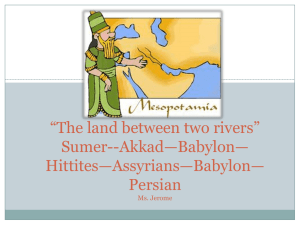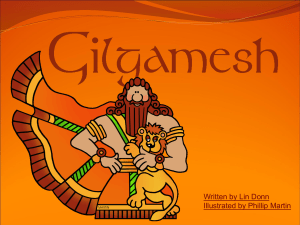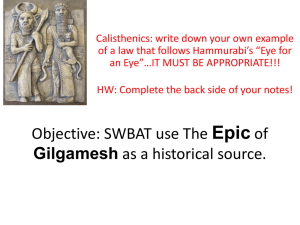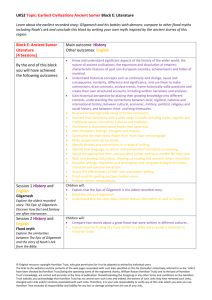Docx
advertisement
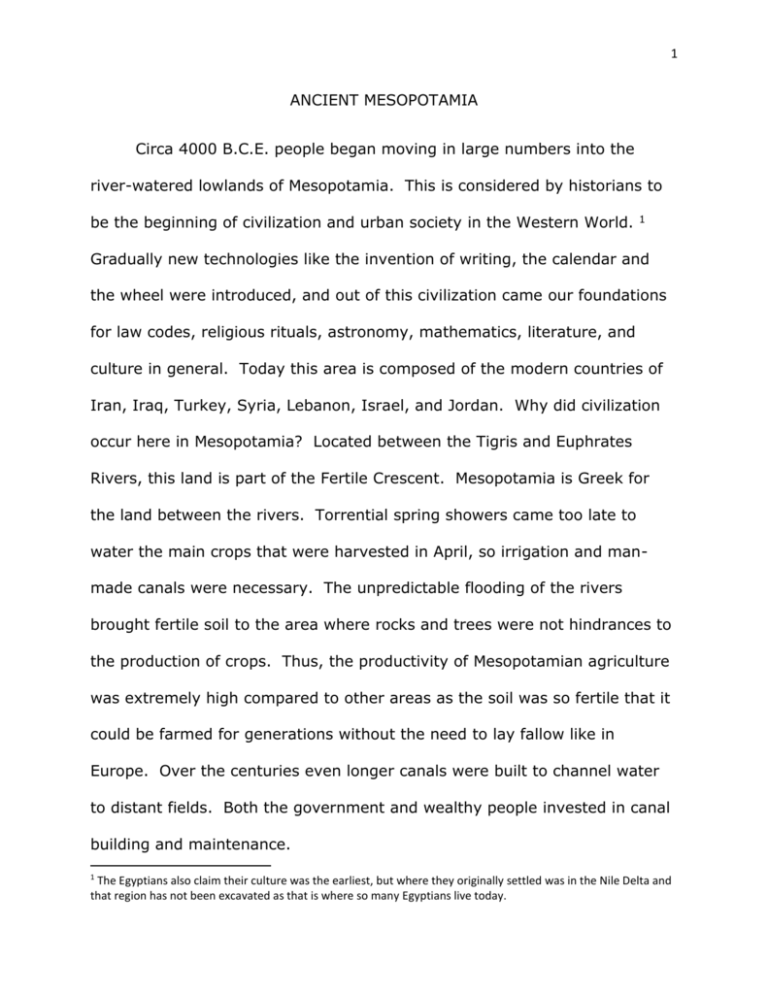
1 ANCIENT MESOPOTAMIA Circa 4000 B.C.E. people began moving in large numbers into the river-watered lowlands of Mesopotamia. This is considered by historians to be the beginning of civilization and urban society in the Western World. 1 Gradually new technologies like the invention of writing, the calendar and the wheel were introduced, and out of this civilization came our foundations for law codes, religious rituals, astronomy, mathematics, literature, and culture in general. Today this area is composed of the modern countries of Iran, Iraq, Turkey, Syria, Lebanon, Israel, and Jordan. Why did civilization occur here in Mesopotamia? Located between the Tigris and Euphrates Rivers, this land is part of the Fertile Crescent. Mesopotamia is Greek for the land between the rivers. Torrential spring showers came too late to water the main crops that were harvested in April, so irrigation and manmade canals were necessary. The unpredictable flooding of the rivers brought fertile soil to the area where rocks and trees were not hindrances to the production of crops. Thus, the productivity of Mesopotamian agriculture was extremely high compared to other areas as the soil was so fertile that it could be farmed for generations without the need to lay fallow like in Europe. Over the centuries even longer canals were built to channel water to distant fields. Both the government and wealthy people invested in canal building and maintenance. 1 The Egyptians also claim their culture was the earliest, but where they originally settled was in the Nile Delta and that region has not been excavated as that is where so many Egyptians live today. 2 Civilization Began in Sumer Historians relate that the earliest civilization in this area of Mesopotamia was in the southern part in the area called Sumer. It was the Sumerians that are given so much credit for their early inventions, including the writing. Their language was neither Semitic nor Indo-European. It is thought that perhaps they came originally from the Caspian Sea area. As they had a surplus of grain far beyond their daily needs, it gave them time to develop new skills and inventions. Now there were artisans, traders, priests, scribes, and merchants that were sustained by the efforts of the farmers. The system of government that emerged went through the normal process of developing civilizations: first clans or tribes, then villages, then cities or towns, and finally city-states. Many scholars believe that cities grew from pilgrimage sites where shrines or temples were located. Even today there are small shrines in Iraq. Over time these city-states were ruled by a priest/king, in what is called a theocracy. Sumer’s kings established theories of justice, raised armies, and built a network of global trade. By about 2500 B.C.E. the combined population of a dozen or so cities was approximately 500,000 people and about four-fifths of them lived in the cities. 3 The Rise of City-States Uruk in today’s Iraq was the first known city-state, and became the prototype for others in the ancient world.2 By 2700 B.C.E. Uruk included seventy-six outlying villages, and the city itself covered more than one thousand acres, and housed nearly 50,000 people. The earliest evidence for writing was discovered here, and its six miles of walls were built by the semi-legendary king, Gilgamesh.3 Ur was another great metropolis of the third millennium b.c.e. Near the center of the city was a temple or ziggurat complex dedicated to the Moon God Nanna and his wife the goddess Ningal.4 This ziggurat acted as a beacon from as far as twenty miles way, and a peasant could see this and be assured of the gods’ protection. War and the Development of Rulers One of the endemic problems in this region of Mesopotamia was war. It was partly due to geography as there were no prohibitive natural barriers to invaders from the East and West. Probably more important, during the earliest of times of development was the conflict between the Sumerian citystates where expanded city boundaries led to quarrels over territory and over diversion of waters from the rivers for irrigation. Every new canal upstream lessened the amount of water downriver.5 Perennial hostilities 2 It is known in the Bible as Erech More on him later when we discuss the Epic of Gilgamesh 4 It is still standing and was partially refurbished with new bricks stamped with Saddam Hussein name on them. 5 A problem even today in the Middle East 3 4 even occurred over the transformation of the structure of government. Councils of aristocratic elders originally were the leaders, and in times of crisis such as war, a single leader was appointed. As the peace intervals shortened this lugal or leader stayed in power longer, and inevitably his military authority extended to all phases of government. The word lugal came to mean king, as over time a lugal would appoint his successor, introducing the concept of dynasties. This increased power of the kings grew to rival the various power of the priests in the temple sites devoted to the numerous deities. In time the king became the deity’s earthly representative, a “divine right” ruler. Rituals instituted by the priesthood sanctified the king and increased the power of the priests. The most important festival occurred on New Year’s Day, when the King ascended in a solemn procession to the top of a city’s principal ziggurat6. Here is where the symbolic marriage was performed uniting him as a substitute for the god to a priestess who represented the Goddess of fertility, Inanna.7 Bureaucracies were added to handle the increased civic activities such as inspectors, tax collectors, and scribes. Development of Writing One of the most important inventions for the world occurred in Sumer. This was writing. As early as 3300 B.C.E. numerical notation tablets were 6 New Year’s Day in ancient times was celebrated usually in March when the lunar calendar began Many scholars of women’s history consider Inanna one of the original creation deities, and as the languages change she becomes Ishtar, Astarte, and Asherah. 7 5 invented, and when the earliest writing was discovered in Uruk it was already highly complex. It is thought that it was invented by merchants to keep track of their transactions, and then the priesthood utilized this. Initially pictographs, symbols changed from concrete representation to abstraction. Next scribes experimented with phonetic symbols, and six hundred characters stood for sounds and ideas rather than objects. By 2500 B.C.E. the reed point they used had taken on a triangular shape that was pushed easily into wet clay, leaving a wedge-shape impression. Much later it was given the name cuneiform from the Latin for wedge-shaped. Akkadian Invasion & Conquest of Sumer The next important development in Mesopotamian history was the invasion and conquest of Sumer by the Akkadian king, Sargon the Great, born about 2335 B.C.E. Ancient mythology relates how Sargon was illegitimate and placed in a reed basket in the Euphrates River.8 This was the first time all of Mesopotamia was united under a single ruler. Sargon established his new capital at Agade, but the site today remains unknown. The dynasty of Sargon’s lasted less than a century due to internal and external conflict. Enheduanna, the daughter of Sargon, is now given credit for being the first known writer by name in world history. Her prayers and hymns to the goddess Inanna have been translated into modern English. Enheduanna had many responsibilities, including being chief priestess to 8 Compare this to the story in the Bible one thousand years later of Moses 6 Nanna, and the substitute ruler for her father when he was away conquering. Epic of Gilgamesh The world’s oldest surviving epic was told and eventually written down during these times, The Epic of Gilgamesh. A cuneiform tablet dates from 2000 B.C.E., but it is thought by scholars that Gilgamesh was a real historical figure, a Sumerian king that may have ruled circa 2600 B.C.E. Like Homer’s Odysseus, Gilgamesh wanders the earth, fighting battles, and sexually abusing women. Gilgamesh’s main goal seems to be the achievement of immortality. Given to Gilgamesh by the Goddess Ishtar (Inanna) was a male companion Enkidu, but Gilgamesh was to acknowledge this gift by sleeping with Ishtar. Unfortunately Enkidu was not civilized so he was given a harlot by Gilgamesh to lie with her for six days and seven nights. When Enkidu came down from the hills, he was civilized, an idea that shows women are the civilizing influence on men. When Gilgamesh later refuses to sleep with Ishtar, she becomes extremely angry and killed Enkidu.9 Woefully mourning his dead friend, Gilgamesh goes in search of the secret to immortality. He met up with an old man and his wife who were just getting off their ark or boat after being saved by the gods who had determined to destroy the world by a flood. This couple informed Gilgamesh 9 This story relates back to the sacred marriage rite when after the male ruler lay with the priestess who represented the goddess on New Year’s Day, he was killed. Gilgamesh did not want this fate. 7 that immortality was unobtainable for him, but gave him the distant location of a plant capable of restoring lost youth. Unfortunately, after finding the plant, Gilgamesh left it unguarded while asleep and a snake stole and ate it. Gilgamesh finally realizes that he should enjoy each day as it comes without worrying about tomorrow. Be kind to your family and those you rule. The moral of this epic is really the search for the meaning of life. Other Notable early inventions Some of the other notable inventions of ancient Mesopotamia were the lunar calendar, sexagesimal system, and the invention of the wheel. While many historians think that women gatherers in the prehistoric times invented the calendar as they have a natural one in their body, others say that it was invented during these times. It was a crucial invention nonetheless as planting and harvesting needed to be done at the proper times. It was the ancient Egyptians who developed the more accurate solar calendar. Developing the sexagesimal system occurred circa 2000-1600 B.C.E. This is the use of the number sixty, where there are twenty-four hours and each hour has sixty minutes, and each minute has sixty seconds. Inventing the wheel probably from a potter’s wheel was another impressive invention for the Sumerians. An ox or donkey hitched to a wheeled court could pull three times the load an animal could cart on its back. Code of Hammurabi 8 The next important invention of the ancient Mesopotamians was accomplished by the Old Babylonians or Akkadians, who conquered the Sumerians. Hammurabi, the most important king of these people reigned for forty-two years circa 1792-1750 B.C.E. He built and established his capital at Babylon (now in ruins). His most famous legacy is undoubtedly the Code of Hammurabi. There were law codes before Hammurabi, like UrNammu, ruler of Ur in the twenty-first century B.C.E. His laws prescribed fines instead of corporal punishment or mutilation for inflicting a physical injury, whereas Hammurabi’s code inflicted such penalties as mutilation, whipping, burning, and drowning. Despite the severity of the Code of Hammurabi, there is a spirit of justice and a sense of responsibility pervading it. The Code has two main characteristics. The first is that the law differed according to the social status of the offender. Aristocrats were not punished as harshly as commoners, nor commoners as harshly as slaves. The second tenet is that the code demanded punishment to fit the crime, hence the famous saying “Eye for an eye, tooth for a tooth.” This, though, only applied among equals. An aristocrat who destroyed a commoner’s eye or a slave’s eye could pay a fine and not lose his own eye. As long as the criminal and victim shared the same social status, the victim could demand exact vengeance. As there were no public prosecutors or district attorneys, people brought their own complaints before the court. 9 Another important concept was that merchants and businessmen were to guarantee the quality of their goods and services. Consumer protection or buyer beware are not just modern ideas. House builders guaranteed their work with their lives. Careless work could result in the collapse of the house, and the death of its inhabitants. If that happened, the builder was put to death. If the son of the house owner died, then the builder’s son was killed. Agriculture issues and marriage and divorce laws were dealt with extensively. Anyone who neglected the irrigation canals that resulted in damaged crops had to bear all the expenses of the lost crops, and those who could not pay were forced into slavery. If a female was raped in the city, then it was her fault as she should have cried for help, but if she was raped in the hills, then she was not guilty as no one would be able to hear her cry out. When she was declared guilty she was killed. Structure and Social Customs of Mesopotamia Society The structure of ancient Mesopotamian society was pyramidal in shape. During the third millennium three distinct classes emerged: aristocracy or patrician, middle group or commoners or plebeians, and the slaves. Within the aristocracy were the king, government officials, most prominent priests, and the wealthiest merchants and landowners. Within the middle group, which were the majority of the ancient Sumerians were free citizens such as farmers, fishermen, artisans, and scribes. Slaves came from forced bondage because of political or economic circumstances, parents 10 selling their children into slavery, and a man or all the family into slavery for debt. Marriage and divorce customs were interesting. Polygyny was probably an option for the wealthy, and there is even some past evidence of polyandry, though the rulers condemned the practice. Parents arranged the marriages. The first step was the betrothal, which was legally recognized when the groom gave money to the bride’s father. A contract was drawn up, specifying the duties of each spouse with even the penalties a husband needed to pay if he decided to divorce his wife. A husband could take one or more concubines, and divorce his wife if she was barren. The family was patrilineal with property passing from father to son. Role of Women The status and various roles of women varied, but labor seems to have been sexually divided. The most common work for women was working in the textile industry as exports of finished cloth were a major source of wealth in much of the area. Women from the upper classes could be priestesses, and some were the highest official in a temple, as mentioned earlier concerning Enheduanna. Women under Mesopotamian law could buy, own and sell property. They could engage in business and be a witness in court. Religious Practices 11 Ancient Sumerian and Mesopotamian religious beliefs and practices were passed down to the next generation, century after century. For the Sumerians that had the belief that Eridu10 was the site of the Creation of Humanity. Thousands of different deities were recognized, even some in animal form. Virtually every realm of nature and human endeavor were presided over by a different deity. Plows, picks, molds for brick making, rain, sun, and the moon each had a deity connected with them. Gods and goddesses were not equal however. Ancient Sumerians believed that there were four main gods of heaven, air, earth and water. One of these always reigned supreme. At first the most powerful was An, ruler of the heavens, but later superseded by Enlil, god of the air. As mentioned earlier the worship of Nanna, the moon god and his wife, Ningal were important. These various deities communicated their wishes to humans by letting the priests and priestesses know what they wanted through such omens as the shape of a liver found in a sacrificial sheep. Scholars state that Sumerian religion was not a particularly hopeful one. According to one Sumerian myth, people were molded out of clay for the sole purpose of serving as the gods’ slaves. Failure to revere and propitiate the deities could bring horrible catastrophes such as floods, drought, pestilence, and raids by hill tribes. As such calamities occurred frequently, people developed chronic anxiety, which made religion powerful and pervasive, greatly benefitting the priesthood and 10 It was an ancient Sumerian city that is now Tell Abu Shahrain in southern Iraq. 12 their temples. These ziggurats had facades of blue-glazed tiles, just as can be seen today on many mosques in Iraq. Temples could own sizable tracts of land, and the priests oversaw the farming. One temple in the city of Lagash provided daily bread and beer rations for 1200 or more people. The ancient Mesopotamians even had a special goddess, Ninkasi, whose name means “lady who fills the mouth”, and we have found a nearly four thousand year old Hymn to Ninkasi, which is a recipe for beer. Microbrewers have made this beer, which was flavored with dates, one of the main staples for the ancient Mesopotamians.
